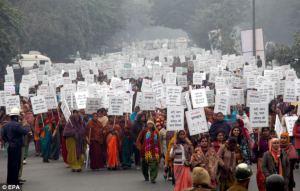Emma Finamore
A month ago today, on the 16th December 2012, five men and one teenage boy were involved in the brutal rape and murder of a female student in

A month on, after unprecedented international media attention and local pressure from on-the-ground protesters and activists, does it look like Delhi – which accounts for 25% of all rapes in a country of 1.2 billion people – can really make the change people are crying out for?
The city authorities have announced a number of new safety proposals, including:
- The introduction of CCT V on public transport
- More police patrols at night
- Checks on drivers and their buses
- The banning of buses with tinted windows
- The recruitment of more female police officers
- A new helpline for women in distress, connected with all police stations in the city
Although useful (if actually put into practice) many of these proposals seem limited to only preventing future crimes very similar to the one that has recently hit the headlines. What of the other crimes, not taking place on public transport but on the streets and in the homes of Delhi?
Four fifths of women report that they fear for their safety on Delhi’s streets at night, unsurprising when much of the city is made up of sprawling slums: a lack of town planning has resulted in many residential areas which are not lit properly and are not served adequately by the city’s infrastructure. Women’s fears are also understandable when you look at how many of them have already experienced sexual harassment or rape: 80% of women in the city claim that they have suffered this. Would the proposed increase in police patrols at night, and a helpline, genuinely minimise the risk and make women less fearful?
Ironically, if you visit the Delhi Police website (www.delhipolice.nic.in) you can see that one of their top priorities is to “Provide a safe environment to working women who work and return during the night”. What of the women who go out at night to be sociable? Do they not deserve protection? And where was this “protection” when that 80% of women were being assaulted? The public rhetoric of the police and the reality on the ground seem to be miles apart from one another.
While our attitude to rape in the West is not exactly something to write home about, this lack of action is almost unsurprising when you look at the wider cultural backdrop in which this particular attack took place: one in which women are far too often treated as second class citizens, and that relieves men of responsibility, but paradoxically treats females as incapable of engaging in anything but domestic life and demonises those who adopt more ‘Western’ habits. Let’s take a look at a few examples to put violence against women into context: in 2012 a Unicef report showed that 57% of Indian boys and 53% of Indian girls (aged 15-19) believe that wife-beating is justified; recently a legislator in Rajasthan proposed banning skirts in girls’ schools as a way of preventing rape; and in December at a public rally, while discussing compensation for rape victims, senior CPM MLA and former West Bengal minister Anisur Rahman asked Chief Minister Mamata Banerjee just how much she would “charge” to get raped. Even a self-styled spiritual leader, Asaram Bapu, accused the woman raped as she traveled on a bus as being “as guilty as her rapists” and defended her attackers: “The five or six drunken men were not the only ones guilty. The girl was also responsible… she should have called the culprits ‘brothers’ and begged them to stop.”
When and how will responsibility for sexual assault be lifted from the shoulders of the victim? When will domestic violence not be seen as the norm by teenagers? When will women who dare to step forward be viewed with admiration rather than scorn and suspicion? One can understand the frustration and anger of the people taking to the streets, but this is something that legislation and the law can only take so far: more police patrols, helplines and stronger sentencing seem tokenistic if authorities (and citizens) don’t or can’t change their attitudes towards reporting sexual violence and dealing with its victims, and towards women in general.
At least one proposal from officials seems like it could start to bring about change: the recruitment of more female police officers. In a country where many men chastise and blame victims of sexual assault, it’s hardly surprising that women find it difficult to talk to male officers (indeed this is the case anywhere in the world). In Delhi, only 7% of officers are women, and of this low number barely any are ever out on patrol, so are very unlikely to be approached by women who have been attacked. If a victim of assault made it to one of the 161 district police stations in the city, in only one of these stations would she find a female house officer. So, simply recruiting more women will not have an impact: the deployment of these women also needs to be carefully considered: if the city can get this right then the plight of the assaulted woman may begin to change.
In terms of this particular case, the knee-jerk reaction from both public and state, vehemently calling for the death penalty is like sticking a small plaster over a massive wound. A holistic approach is needed for a real effect to take hold: in the home, in education, in the media, with leaders of the tribal communities. Delhi needs to reach for long-term change; killing these men will not achieve that.
